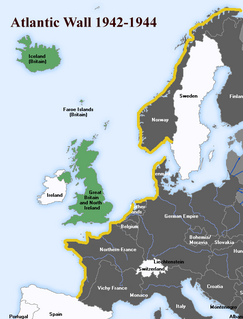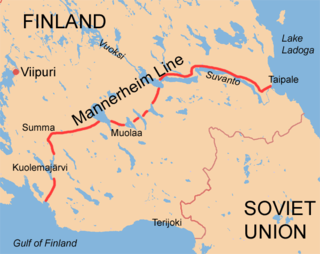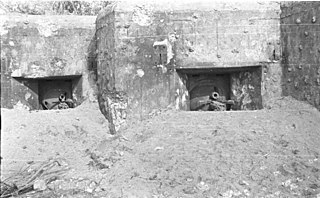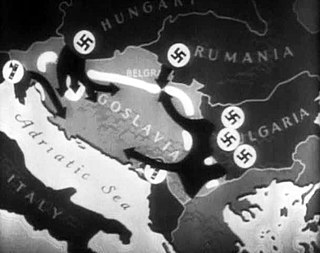
The Maginot Line, named after the French Minister of War André Maginot, is a line of concrete fortifications, obstacles, and weapon installations built by France in the 1930s to deter invasion by Germany and force them to move around the fortifications.

The Atlantic Wall was an extensive system of coastal defences and fortifications built by Nazi Germany between 1942 and 1944, along the coast of continental Europe and Scandinavia as a defence against an anticipated Allied invasion of Nazi-occupied Europe from the United Kingdom, during World War II. The manning and operation of the Atlantic Wall was administratively overseen by the German Army, with some support from Luftwaffe ground forces. The Kriegsmarine maintained a separate coastal defence network, organised into a number of sea defence zones.

The Siegfried Line, known in German as the Westwall, was a German defensive line built during the 1930s opposite the French Maginot Line. It stretched more than 630 km (390 mi); from Kleve on the border with the Netherlands, along the western border of the old German Empire, to the town of Weil am Rhein on the border to Switzerland – and featured more than 18,000 bunkers, tunnels and tank traps.

The Mannerheim Line was a defensive fortification line on the Karelian Isthmus built by Finland against the Soviet Union. During the Winter War it became known as the Mannerheim Line, after Field Marshal Baron Carl Gustaf Emil Mannerheim. The line was constructed in two phases: 1920–1924 and 1932–1939. By November 1939, when the Winter War began, the line was by no means complete.

Dravograd is a small town in northern Slovenia, close to the border with Austria. It is the seat of the Municipality of Dravograd. It lies on the Drava River at the confluence with the Meža and the Mislinja. It is part of the traditional Slovenian provinces of Carinthia and the larger Carinthia Statistical Region.

Črneče is a village on the right bank of the Drava River in the Municipality of Dravograd in the Carinthia region in northern Slovenia.

The Stalin Line was a line of fortifications along the western border of the Soviet Union. Work began on the system in the 1920s to protect the USSR against attacks from the West. The line was made up of concrete bunkers and gun emplacements, somewhat similar to, but less elaborate than the Maginot Line. It was not a continuous line of defense along the entire border, but rather a network of fortified districts, meant to channel potential invaders along certain corridors.

Leon Rupnik, also known as Lav Rupnik or Lev Rupnik was a Slovene general in the Kingdom of Yugoslavia who collaborated with the Fascist Italian and Nazi German occupation forces during World War II. Rupnik served as the President of the Provincial Government of the Nazi-occupied Province of Ljubljana from November 1943 to early May 1945. Between September 1944 and early May 1945, he also served as chief inspector of the Slovene Home Guard, a collaborationist militia, although he did not have any military command until the last month of the war.

The so-called Molotov Line was a system of border fortified regions built by the Soviet Union in the years 1940–1941 along its new western borders. These borders were the result of the Occupation of the Baltic States, Eastern Poland and Bessarabia in 1940.

The Invasion of Yugoslavia, also known as the April War or Operation 25, was a German-led attack on the Kingdom of Yugoslavia by the Axis powers which began on 6 April 1941 during World War II. The order for the invasion was put forward in "Führer Directive No. 25", which Adolf Hitler issued on 27 March 1941, following a Yugoslav coup d'état that overthrew the pro-Axis government.
Lyenko Urbanchich was a Slovenian-born Australian political activist. During World War II he was a Slovene Home Guard propagandist.

The Alpine Wall was an Italian system of fortifications along the 1,851 km (1,150 mi) of Italy's northern frontier. Built in the years leading up to World War II at the direction of Italian dictator Benito Mussolini, the defensive line faced France, Switzerland, Austria, and Yugoslavia. It was defended by the "Guardia alla Frontiera" (GaF), Italian special troops.

The Province of Ljubljana was the central-southern area of Slovenia. In 1941, it was annexed by Fascist Italy, and after 1943 occupied by Nazi Germany. Created on May 3, 1941, it was abolished on May 9, 1945, when the Slovene Partisans and partisans from other parts of Yugoslavia liberated it from the Nazi Operational Zone of the Adriatic Littoral. Its administrative centre was Ljubljana.

Planina is a village in the Municipality of Postojna in the Inner Carniola region of Slovenia. It includes the hamlets of Gornja Planina, Dolnja Planina, and Grič in the main settlement as well as Kačja Vas to the southwest and Malni and Hasberg to the south.

Claustra Alpium Iuliarum was a defense system within the Roman Empire between Italia and Pannonia that protected Italy from possible invasions from the East. It secured the Postojna Gate, the land link between the eastern and western part of the empire, and thus the Claustra represented an inner border defense of the empire. Unlike a linear rampart, the Claustra consisted of a series of interconnected fortifications with its center at Castra ad Fluvium Frigidum ; other important fortresses were Ad Pirum on today's Hrušica Plateau and Tarsatica, now a part of the city of Rijeka. They had been governed from the town of Aquileia.
The Battle of the Metaxas Line, also known in Greece as the Battle of the Forts, was the first battle during the German invasion of Greece in World War II. The Germans succeeded in capturing several individual forts but failed to breach the fortified Metaxas Line in general. The 2nd Panzer division with an enveloping move crossed the Yugoslavian borders, overcame Yugoslav and Greek resistance and captured Thessaloniki on the 9th of April. The capture of Thessaloniki forced the Greek East Macedonia Army Section to surrender on the 10th of April and the Metaxas Line battle was over.
The 1st Army Group was a Royal Yugoslav Army formation mobilised prior to the German-led Axis invasion of Yugoslavia in April 1941 during World War II. It consisted of the 4th Army, 7th Army, and the 1st Cavalry Division, which was the army group reserve. It was responsible for the defence of northwestern Yugoslavia, with the 4th Army defending the eastern sector along the Yugoslav–Hungarian border, and the 7th Army defending the western sector along the borders with Germany and Italy. Like all Yugoslav formations at the time, the 1st Army Group had serious deficiencies in both mobility and firepower.

The 7th Army was a Royal Yugoslav Army formation raised prior to the German-led Axis invasion of Yugoslavia in April 1941, during World War II. It consisted of two divisions, two brigade-strength mountain detachments, and a brigade-strength infantry detachment. It formed part of the 1st Army Group, and was responsible for the defence of Yugoslavia's north-western frontier with Italy and Germany. Like all Yugoslav formations at the time, the 7th Army had serious deficiencies in both mobility and firepower.

The 32nd Infantry Division Triglavski was a short-lived Royal Yugoslav Army infantry formation raised prior to the German-led Axis invasion of the Kingdom of Yugoslavia in April 1941. It was largely mobilised from the Dravska military district, and, like all Yugoslav infantry divisions of the time, was a very large and unwieldy formation which was almost entirely reliant on animal transport for mobility. Commanded by Divizijski đeneral Dragiša Pandurović and largely manned by Slovene troops, the division also lacked modern arms and sufficient ammunition.
The 38th Infantry Division Dravska was a short-lived Royal Yugoslav Army infantry formation raised prior to the German-led Axis invasion of the Kingdom of Yugoslavia in April 1941. It was largely mobilised from the Dravska divisional district, and, like all Yugoslav infantry divisions of the time, was a very large and unwieldy formation which was almost entirely reliant on animal transport for mobility. Commanded by Divizijski đeneral Čedomir Stanojlović and largely manned by Slovene and ethnic German troops, the division also lacked modern arms and sufficient ammunition to meet the German onslaught.


















